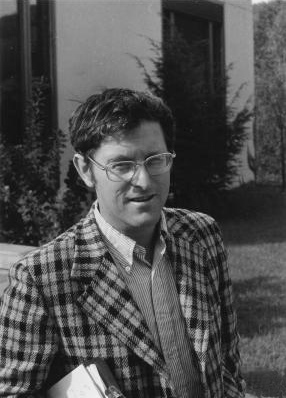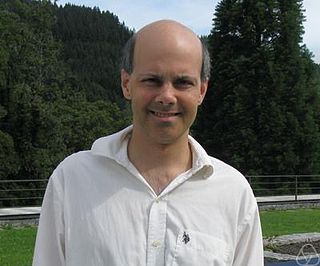In mathematics — specifically, in large deviations theory — a rate function is a function used to quantify the probabilities of rare events. Such functions are used to formulate large deviation principles. A large deviation principle quantifies the asymptotic probability of rare events for a sequence of probabilities.
In probability theory, the theory of large deviations concerns the asymptotic behaviour of remote tails of sequences of probability distributions. While some basic ideas of the theory can be traced to Laplace, the formalization started with insurance mathematics, namely ruin theory with Cramér and Lundberg. A unified formalization of large deviation theory was developed in 1966, in a paper by Varadhan. Large deviations theory formalizes the heuristic ideas of concentration of measures and widely generalizes the notion of convergence of probability measures.

Daniel Wyler Stroock is an American mathematician, a probabilist. He is regarded and revered as one of the fundamental contributors to Malliavin calculus with Shigeo Kusuoka and the theory of diffusion processes with S. R. Srinivasa Varadhan with an orientation towards the refinement and further development of Itô’s stochastic calculus.
In information theory, the entropy power inequality (EPI) is a result that relates to so-called "entropy power" of random variables. It shows that the entropy power of suitably well-behaved random variables is a superadditive function. The entropy power inequality was proved in 1948 by Claude Shannon in his seminal paper "A Mathematical Theory of Communication". Shannon also provided a sufficient condition for equality to hold; Stam (1959) showed that the condition is in fact necessary.
In mathematics, Laplace's principle is a basic theorem in large deviations theory which is similar to Varadhan's lemma. It gives an asymptotic expression for the Lebesgue integral of exp(−θφ(x)) over a fixed set A as θ becomes large. Such expressions can be used, for example, in statistical mechanics to determining the limiting behaviour of a system as the temperature tends to absolute zero.
In mathematics, the Freidlin–Wentzell theorem is a result in the large deviations theory of stochastic processes. Roughly speaking, the Freidlin–Wentzell theorem gives an estimate for the probability that a (scaled-down) sample path of an Itō diffusion will stray far from the mean path. This statement is made precise using rate functions. The Freidlin–Wentzell theorem generalizes Schilder's theorem for standard Brownian motion.
In mathematics, the Dawson–Gärtner theorem is a result in large deviations theory. Heuristically speaking, the Dawson–Gärtner theorem allows one to transport a large deviation principle on a “smaller” topological space to a “larger” one.
In mathematics, Varadhan's lemma is a result from the large deviations theory named after S. R. Srinivasa Varadhan. The result gives information on the asymptotic distribution of a statistic φ(Zε) of a family of random variables Zε as ε becomes small in terms of a rate function for the variables.
In mathematics — specifically, in large deviations theory — the contraction principle is a theorem that states how a large deviation principle on one space "pushes forward" to a large deviation principle on another space via a continuous function.

Bjorn Mikhail Poonen is a mathematician, four-time Putnam Competition winner, and a Distinguished Professor in Science in the Department of Mathematics at the Massachusetts Institute of Technology. His research is primarily in arithmetic geometry, but he has occasionally published in other subjects such as probability and computer science. He has edited two books.
In mathematics, exponential equivalence of measures is how two sequences or families of probability measures are "the same" from the point of view of large deviations theory.

Harry Kesten was a Jewish American mathematician best known for his work in probability, most notably on random walks on groups and graphs, random matrices, branching processes, and percolation theory.
In mathematics and information theory, Sanov's theorem gives a bound on the probability of observing an atypical sequence of samples from a given probability distribution. In the language of large deviations theory, Sanov's theorem identifies the rate function for large deviations of the empirical measure of a sequence of i.i.d. random variables.
The Annals of Probability is a leading peer-reviewed probability journal published by the Institute of Mathematical Statistics, which is the main international society for researchers in the areas probability and statistics. The journal was started in 1973 as a continuation in part of the Annals of Mathematical Statistics, which was split into the Annals of Statistics and this journal.

Gérard Ben Arous is a French mathematician, specializing in stochastic analysis and its applications to mathematical physics. He served as the director of the Courant Institute of Mathematical Sciences at New York University from 2011 to 2016.

Alice Guionnet is a French mathematician known for her work in probability theory, in particular on large random matrices.

Aleksandr Alekseevich Borovkov is a Russian mathematician.

Ofer Zeitouni is an Israeli mathematician, specializing in probability theory.

Jean Bertoin is a French mathematician, specializing in probability theory and professor at the University of Zurich.

Erwin Bolthausen is a Swiss mathematician, specializing in probability theory, statistics, and stochastic models in mathematical physics.









